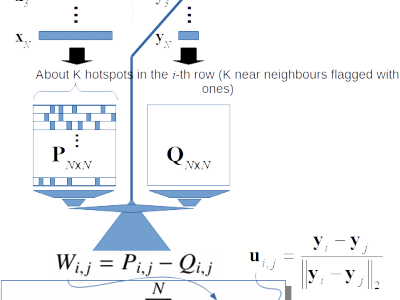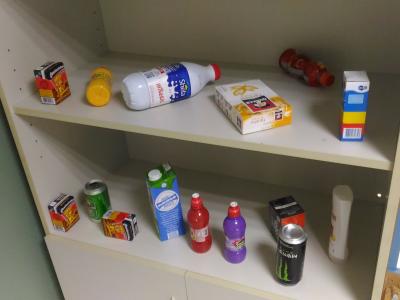Machine Learning

Parallel sentences in English and French, with mathematical expressions tokenized. The French sentences were extracted from course notes on error-correcting codes authored by Dr. Monica Nevins, University of Ottawa.
- Categories:
 138 Views
138 ViewsFrom state-of-the-art visualization algorithms, we distill six working principles which are, by hypothesis, sufficient to produce visual projections qualitatively similar to those obtained with these state-of-the-art algorithms. These working principles are presented through the geometrical reasoning of the classical Multidimensional Scaling algorithm, and their effectiveness is illustrated through a novel straightforward algorithm for image visualization.
- Categories:
 123 Views
123 ViewsThe dataset has Gaussian Blobs of varying samples, centers and features. The number of samples ranges from 500 to 50,000. Similarly, the number of centers varies from 2 to 100, while the number of features varies from 2 to 2048. These different sets of Gaussian blobs can be used for testing clustering algorithms for their scalability and effectiveness. There are two kinds of files inside the compressed sets. Files ending with "_X.csv" consist of datapoints, while the files ending with "_y.csv" represent respective class data.
- Categories:
 2874 Views
2874 ViewsThe dataset is composed of digital signals obtained from a capacitive sensor electrodes that are immersed in water or in oil. Each signal, stored in one row, is composed of 10 consecutive intensity values and a label in the last column. The label is +1 for a water-immersed sensor electrode and -1 for an oil-immersed sensor electrode. This dataset should be used to train a classifier to infer the type of material in which an electrode is immersed in (water or oil), given a sample signal composed of 10 consecutive values.
- Categories:
 2349 Views
2349 ViewsOptical Character Recognition (OCR) system is used to convert the document images, either printed or handwritten, into its electronic counterpart. But dealing with handwritten texts is much more challenging than printed ones due to erratic writing style of the individuals. Problem becomes more severe when the input image is doctor's prescription. Before feeding such image to the OCR engine, the classification of printed and handwritten texts is a necessity as doctor's prescription contains both handwritten and printed texts which are to be processed separately.
- Categories:
 23182 Views
23182 ViewsAnnotated image dataset of household objects from the RoboFEI@Home team
This data set contains two sets of pictures of household objects, created by the RoboFEI@Home team to develop object detection systems for a domestic robot.
The first data set was created with objects from a local supermarket. Product brands are typical from Brazil. The second data set is composed of objects from the RoboCup@Home 2018 OPL competition.
- Categories:
 13995 Views
13995 ViewsThis dataset gives a cursory glimpse at the overall sentiment trend of the public discourse regarding the COVID-19 pandemic on Twitter. The live scatter plot of this dataset is available as The Overall Trend block at https://live.rlamsal.com.np. The trend graph reveals multiple peaks and drops that need further analysis. The n-grams during those peaks and drops can prove beneficial for better understanding the discourse.
- Categories:
 6255 Views
6255 ViewsMost text-simplification systems require an indicator of the complexity of the words. The prevalent approaches to word difficulty prediction are based on manual feature engineering. Using deep learning based models are largely left unexplored due to their comparatively poor performance. We have explored the use of one of such in predicting the difficulty of words. We have treated the problem as a binary classification problem. We have trained traditional machine learning models and evaluated their performance on the task.
- Categories:
 2741 Views
2741 ViewsDataSet used in learning process of the traditional technique's operation, considering different devices and scenarios, the proposed approach can adapt its response to the device in use, identifying the MAC layer protocol, perform the commutation through the protocol in use, and make the device to operate with the best possible configuration.
- Categories:
 576 Views
576 ViewsWe present here one of the first studies that attempt to differentiate between genuine and acted emotional expressions, using EEG data. We present the first EEG dataset with recordings of subjects with genuine and fake emotional expressions. We build our experimental paradigm for classification of smiles; genuine smiles, fake/acted smiles and neutral expression. For the full details please refere to our paper entitled:
Discrimination of Genuine and Acted Emotional Expressions using EEG Signal and Machine Learning
- Categories:
 2757 Views
2757 Views






